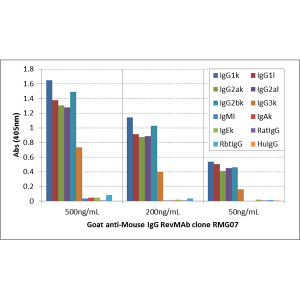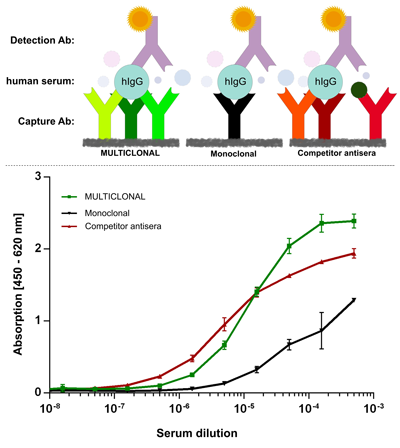
ELISA of mouse immunoglobulins shows RMG07 reacts to mouse IgG1, IgG2a, IgG2b, and IgG3; no cross reactivity with IgM, IgA, IgE, human IgG, rat IgG, and rabbit IgG. The plate was coated with 50 ng/well of different immunoglobulins. 500 ng/mL, 200 ng/mL, o
anti-IgG (mouse), Goat Monoclonal (RMG07)
REV-41-1045-00
ApplicationsFlow Cytometry, ImmunoPrecipitation, ELISA, ImmunoCytoChemistry, ImmunoHistoChemistry
Product group Antibodies
ReactivityMouse
Overview
- SupplierRevMAb Biosciences
- Product Nameanti-IgG (mouse), Goat Monoclonal (RMG07)
- Delivery Days Customer10
- ApplicationsFlow Cytometry, ImmunoPrecipitation, ELISA, ImmunoCytoChemistry, ImmunoHistoChemistry
- CertificationResearch Use Only
- ClonalityMonoclonal
- Clone IDRMG07
- Concentration1 mg/ml
- HostGoat
- IsotypeIgG
- Protein IDP01868
- Protein NameIg gamma-1 chain C region secreted form
- Scientific DescriptionImmunoglobulin G (IgG), a monomer, is the predominant Ig class present in serum. Produced as part of the secondary immune response to an antigen, this class of immunoglobulin constitutes approximately 75% of total serum Ig. In mice there are four different IgG subclasses known, namely IgG1, IgG2a/c, IgG2b, and IgG3, which are determined by their respective C regions gamma1, gamma2a/c, gamma2b, and gamma3. The mutually exclusive occurrence of either IgG2a or IgG2c is determined by the genetic background of the mouse strain; however, both IgG2a and IgG2c are thought to have similar characteristics. Because of its relative abundance and excellent specificity toward antigens, IgG is the principle antibody used in immunological research and clinical diagnostics. This anti-mouse secondary antibody has well-characterized specificity for mouse IgG immunoglobulins and is useful in the detection, sorting or purification of its specified target. In general, secondary antibodies offer increased versatility enabling users to use many detection systems (e.g. HRP, AP, fluorescence). They can also provide greater sensitivity through signal amplification as multiple secondary antibodies can bind to a single primary antibody. - Recombinant Antibody. This antibody reacts to Mouse IgG, including IgG1, IgG2a, IgG2b, and IgG3. No cross reactivity with IgM, IgA, IgE, human IgG, rat IgG, or rabbit IgG. Applications: IP, ICC, IHC, FACS, ELISA. Source: Goat. Liquid. 50% Glycerol/PBS with 1% BSA and 0.09% sodium azide. Immunoglobulin G (IgG), a monomer, is the predominant Ig class present in serum. Produced as part of the secondary immune response to an antigen, this class of immunoglobulin constitutes approximately 75% of total serum Ig. In mice there are four different IgG subclasses known, namely IgG1, IgG2a/c, IgG2b, and IgG3, which are determined by their respective C regions gamma1, gamma2a/c, gamma2b, and gamma3. The mutually exclusive occurrence of either IgG2a or IgG2c is determined by the genetic background of the mouse strain; however, both IgG2a and IgG2c are thought to have similar characteristics. Because of its relative abundance and excellent specificity toward antigens, IgG is the principle antibody used in immunological research and clinical diagnostics. This anti-mouse secondary antibody has well-characterized specificity for mouse IgG immunoglobulins and is useful in the detection, sorting or purification of its specified target. In general, secondary antibodies offer increased versatility enabling users to use many detection systems (e.g. HRP, AP, fluorescence). They can also provide greater sensitivity through signal amplification as multiple secondary antibodies can bind to a single primary antibody.
- ReactivityMouse
- Storage Instruction-20°C
- UNSPSC12352203


